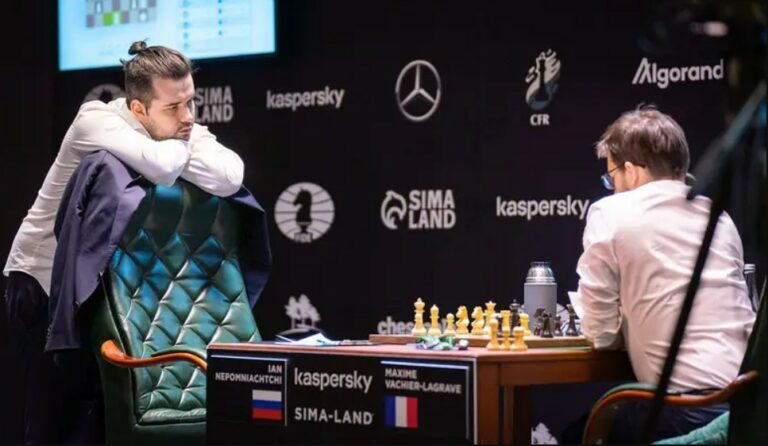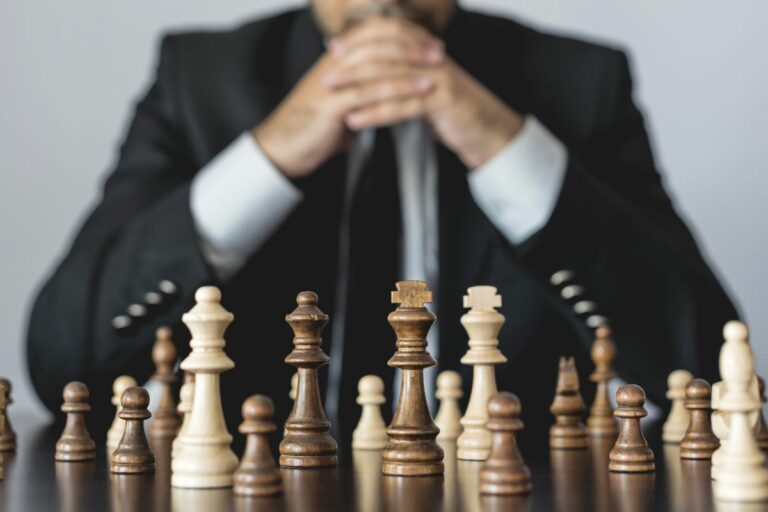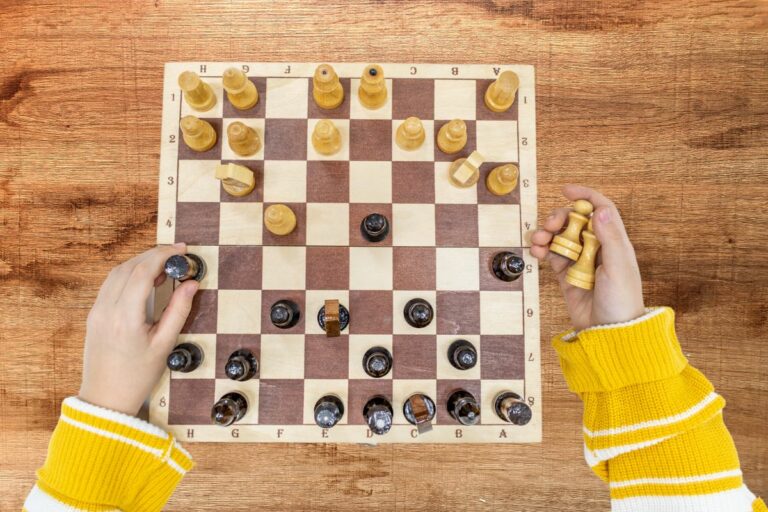Is It Bad to Draw in Chess? 4 Scenarios Explained
If you watch or study enough Grandmaster games, you will find that the result that occurs more than any other is the draw, and despite that, new players often shy away from accepting or offering them, thinking draws are somehow something bad.
Some argue that draws undermine the game’s competitive nature, So, is it bad to draw in chess?
It’s not bad to draw in chess. It mainly depends on the context of the game, but drawing can be a strategic decision to secure a favorable outcome, avoid taking unnecessary risks, or save time and energy instead of fighting a pointless battle.
Keep reading to learn more about when and when not to offer a draw and how to offer a draw without offending your opponent.
Is It Bad to Draw in Chess?

Draws occur naturally in chess, just like wins and losses. Some games inevitably reach a draw, where neither player can secure a win unless a mistake is made.
Due to the closely matched skill levels of top players and their deep preparations, most high-level games end in draws. However, an excessive number of draws can pose challenges. The draws of top players are often considered a serious problem plaguing the competitiveness of chess, and it’s often referred to as the “Grandmaster Draw Problem“.
The objective should always be to strive for victory. While it’s acceptable to experience a few non-winning games, it is equally important to develop the ability to pursue wins rather than merely aiming to avoid losses.
When to Draw
Draws are generally not bad. It is acceptable to agree on a draw when the position becomes stagnant or evenly matched, and no feasible approach seems likely to change that without either side taking a significant risk.
Draws are always preferable to losses, so it’s fine to draw when both players perform well (or both perform equally bad). However, if a draw is offered prematurely, before fully exploring the potential of the position, it becomes less desirable.
Here are some situations in which it’s acceptable to draw:
- Limited checkmating material, such as having only two knights.
- An evenly matched position with no clear path for development without taking substantial risks.
- Fatigue after playing for an extended period, where the opportunity to open up the game exists but energy levels are compromised.
- Offering a draw to conserve energy for subsequent matches against strong opponents.
- Offering a draw in team matches to achieve a favorable overall result, although this practice can be controversial in events like chess Olympics and team tournaments.
Keep in mind that offering a draw on the board is something, and pre-agreeing to a draw is something else.
When Not to Draw
Proposing a draw while facing inevitable defeat demonstrates either a lack of game etiquette or rudeness. Similarly, offering a draw when in a winning position displays weakness and uncertainty in converting advantages.
You also should never draw for reasons like fixing results, manipulating next-round pairings, or for financial gains. Basically, just don’t sell out.
One Exception
An exception arises when offering a draw from a technically inferior position if the opponent is under significant time pressure. In such cases, exploiting their time constraints can lead to unexpected opportunities and turnaround victories. However, this approach remains controversial.
Do Chess Matches Often End in a Draw?
As I said in the intro, If you enjoy watching top-level chess games like me, you’ve probably noticed that most matches between grandmasters often end in a draw. Some argue that this prevalence of draws is a problem in top-level chess. However, I have a different view.
Analyzing the total number of games played by grandmasters with a FIDE ELO rating of 2,600 and above from 1970 to August 2017, we find that the number of draws remains consistently around the 50% mark.
| Result | Percentage |
| White Win | 28.85% |
| Black Win | 18.00% |
| Draw | 53.14% |
To make it simpler, check out this pie chart; you’ll notice that the draws represent the largest portion.

This data, discussed in an insightful analysis by Qiyu Zhou on ChessBase, challenges the notion that draws have become more common in chess due to the accessibility of chess engines.
Contrary to popular belief, the availability of chess engines has not tilted the playing field. In the past, when no one had access to chess engines, players competed on relatively similar skill levels.
Nowadays, with chess engines widely accessible and highly powerful, the overall strength of players has increased proportionally. Thus, the prevalence of draws in top-level chess can be attributed to the well-matched playing field rather than the impact of chess engines.
Is It Rude to Offer a Draw During a Match?
In certain circumstances, offering a draw in chess is not considered rude. However, engaging in practices that manipulate game outcomes, such as pre-arranging draws to achieve specific tournament results, is both impolite and prohibited. Violating this rule can result in penalties.
Furthermore, it is considered discourteous to offer a draw when facing an imminent loss. If your opponent has a clear advantage and victory is imminent within a move or two, the appropriate course of action is to resign gracefully. Requesting a draw in such a situation, where the opponent has a significant chance of winning, is inappropriate.
To know when is it ok and when is it not to offer Draws, check out my full guide on offering draws in chess here. It’s like a 3-minute read and it’s absolutely worth your time.
Avoid This
Becoming a chess player who persistently offers draws from a losing position is highly unfavorable. This behavior is widely disliked and can lead to complaints filed against you for misconduct.
Failing to comply with the regulations set by arbiters may result in forfeiting the game or even being expelled from the tournament. It is crucial to refrain from engaging in such actions to maintain a positive reputation and uphold fair play.
What Is the Right Way to Offer a Draw?

The accepted method of offering a draw is to verbally state, “I propose a draw” or “I offer a draw,” while the timer is running on your turn, and then click the timer to switch it to your opponent’s time.
In the past, players would extend their hand for a handshake while the clock was running, but this practice has dwindled. It caused confusion, as many mistook it for resignation, leading to chaos. Nowadays, this approach is rarely used, except by a few older players.
The current practice involves making a move while the clock is running on your turn and asking, “Draw?” before clicking the timer.
It is crucial to offer the draw with the clock still running and refrain from stopping it. Stopping the clock and extending a hand signifies resignation, not a draw. At this point, your opponent has three options:
- They can accept the draw by responding positively, stopping the clock, and shaking hands.
- They can decline the draw by saying “no” or stating that the game continues.
- They can decline the draw by making a move and pressing the clock.
Remember not to propose a draw without making a move yourself. Your opponent might respond with, “I’ll think about it.” The draw offer remains valid until your opponent makes a move, but if they decline the draw and keep on playing and you start turning the game around, they can’t go back on their answer and accept the draw.
Once they reject your offer, the offer is no longer there and the game continues, they can’t go back and accept it. Instead, they will need to make a new draw offer themselves, and all of the rules discussed so far applies then.
Lastly, ensure that you do not offer a draw before reaching the 30th move. Offering a draw to end the game abruptly is prohibited before reaching this milestone.
Why Do Chess Players Agree to Draw?

Have you ever wondered why professional chess players often request or propose a draw? Let’s explore the various scenarios that lead to these decisions.
Insufficient Material
When a player lacks enough chess pieces to checkmate the opponent’s king, known as insufficient mating material, the game is a daw.
In such situations, experienced players can anticipate this outcome and propose a draw, as continuing the game would serve no purpose.
Stalemate
Stalemate occurs when a player’s king is not in check, but they have no legal moves left to continue the game. Instead of wasting time in a futile position, players may agree to a draw.
Although actual stalemates are rare at the grandmaster level, when players foresee an inevitable stalemate, they promptly agree to a draw.
Repetition
If the same position repeats three times during a game, the player with the move can claim a draw according to the common rule. However, repetition doesn’t necessarily need to occur on the board.
Players might find themselves in a mutual zugzwang, where any other move would result in a disadvantageous position.
In such cases, they may make a single move and then agree to a draw, knowing that repeating the same moves is inevitable.
Fatigue
Chess demands significant mental and physical exertion. To conserve energy, players often agree to a draw when they believe the game is heading towards a drawish position. This decision saves them time and energy, allowing them to better prepare for their next game.
Understanding the reasons behind draws in chess provides insights into the strategic and practical considerations that players take into account during competitive play.
The Issue of Prearranged Draws

Prearranged draws in chess happen when players agree to end the game in a tie before they even start playing. They decide together that the game will be a draw without making any moves.
Players may agree to a draw for different reasons, like wanting to protect their tournament standing or avoid a tough opponent. However, this practice is often seen as taking away from the competitive and exciting nature of chess.
To discourage prearranged draws, chess organizations have made rules against them. These rules may limit when players can agree to a draw or impose punishments for doing so.
The goal is to encourage players to play actively and try to win, rather than settling for a draw without really playing the game.
This practice of prearranged draws has been a topic of debate in the chess community. Critics argue that it undermines the competitive spirit of the game and can lead to less exciting or engaging play. As a result, chess organizations and governing bodies have implemented measures to discourage or penalize prearranged draws.
Whether we like it or not, and whether it’s penalized or not, pre-arranged draws are a reality in chess and will continue to be, but luckily they are much rarer than most people believe them to be.
Keep in mind that in some tournaments or chess events, pre-agreeing to draws can get you or even your whole team penalized.
Conclusion
In conclusion, the decision to offer a draw in chess depends on the context of the game. Draws can be an acceptable outcome when the game is naturally heading for a draw anyway.
However, offering a draw must be done in the right way to ensure proper sportsmanship and understanding between players. It is important to follow the official protocol, such as proposing a draw with the clock running and making a move before doing so.
Offering a draw inappropriately, such as when in a losing position or as a means to fix a game, can be seen as rude or even illegal.
Understanding the nuances and etiquette surrounding draws in chess allows for fair and respectful gameplay, maintaining the integrity and enjoyment of the game for all involved.
If you did find this article helpful, please consider sharing, as it can help this little site grow 🙏







